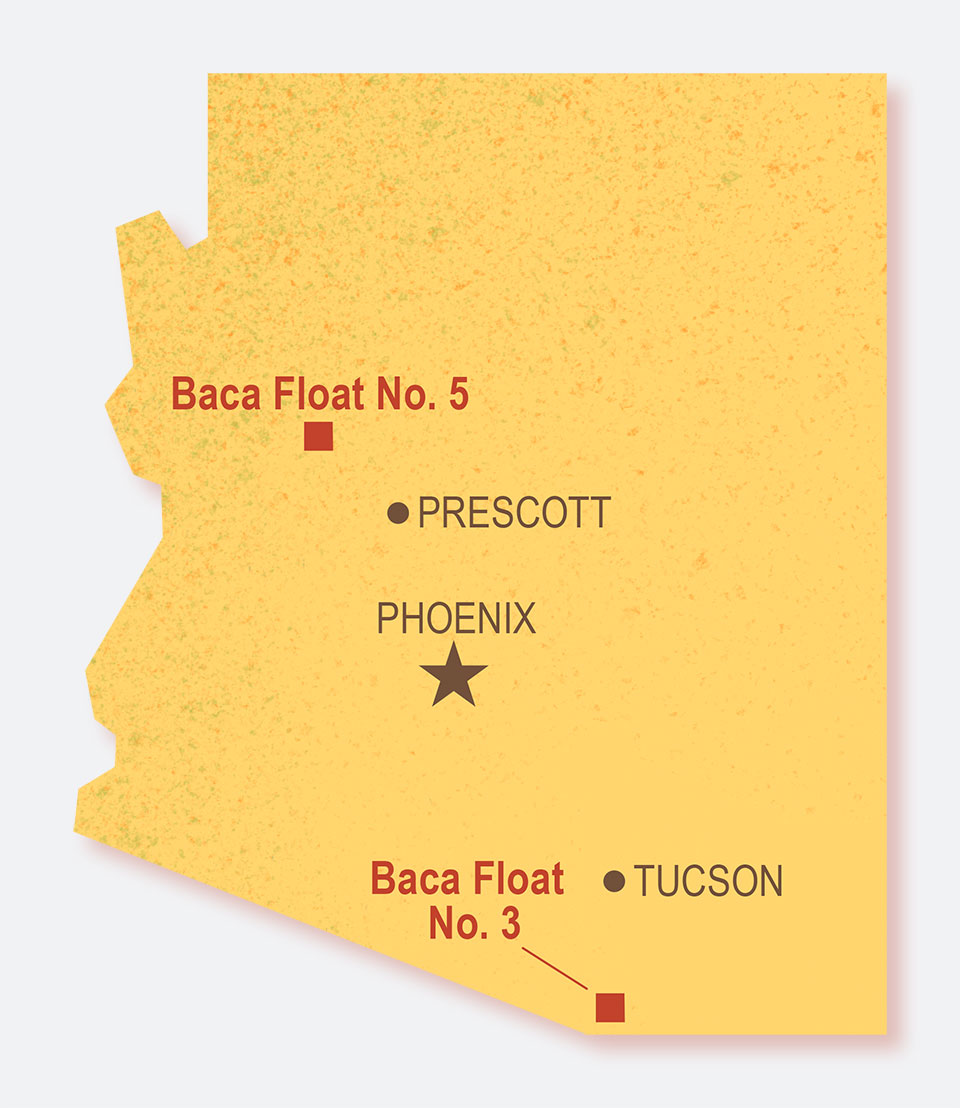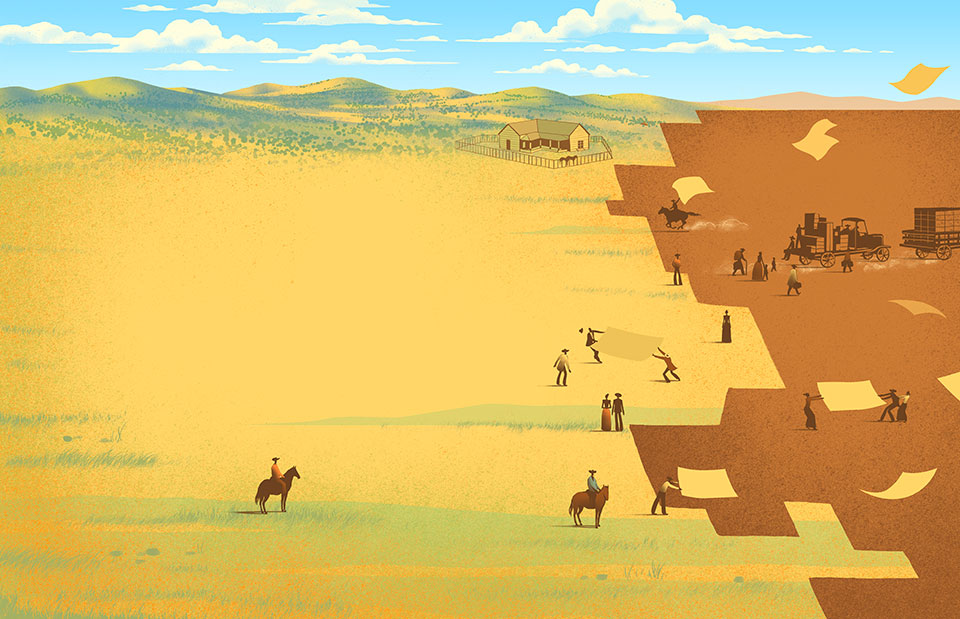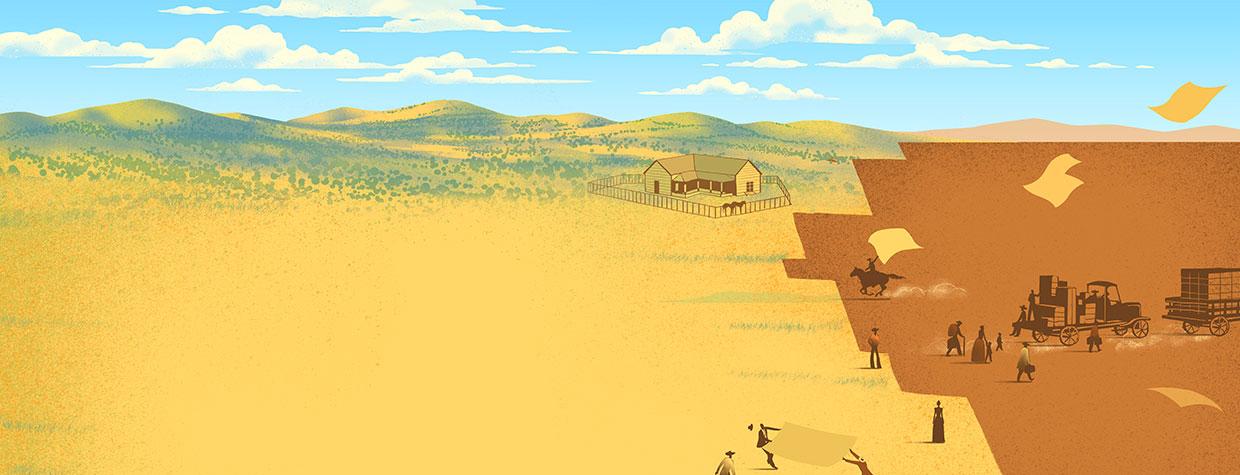Don Luis María Cabeza de Baca would never know what he started. Married three times, the wealthy New Mexico sheepherder fathered as many as 22 children. But Cabeza de Baca’s 19th century land grant proved to be his enduring legacy, giving birth to two of the most storied land holdings in Arizona, the Baca Floats.
These twin parcels separately came to embody the highest ideals and the basest impulses of the Western frontier. One became a legendary ranch, the other the subject of a bitter land dispute that saw homesteaders thrown off their lands and imperiled the status of a national monument.
orn in Santa Fe, Cabeza de Baca claimed an illustrious pedigree, tracing his bloodline to the celebrated 16th century Spanish explorer Álvar Núñez Cabeza de Vaca. But he was not revered by the native Puebloans, who accused him of intimidation and fraud. Ultimately, he was prosecuted for abusing the local Natives and later killed by Mexican soldiers over contraband pelts.
In 1821, Cabeza de Baca petitioned the Spanish authorities for a land grant for himself and his 17 sons near present-day Las Vegas, New Mexico. As if an omen, the 500,000-acre grant ran into trouble from the start when Spanish authorities approved Cabeza de Baca’s grant after Mexico had won its independence.
The Mexican government eventually honored the grant, though, and Cabeza de Baca was free to build a small dwelling on the land he called Las Vegas Grandes, where he grazed large herds of livestock. But within a few years, raiding Comanches chased him off and he retreated to the family hacienda in Peña Blanca, where he was later killed.
After the U.S. Army subdued the Comanches, settlers once again returned to the frontier, and a group of them applied to Mexican authorities for a community grant at Las Vegas Grandes. To the Baca family’s consternation, the Mexican government granted it. Cabeza de Baca’s heirs protested but got no relief until after the Treaty of Guadalupe Hidalgo ceded the territory to the United States, which eventually recognized both claims as legitimate.

Rather than evict the 2,200 residents living in Las Vegas by then, Congress authorized Cabeza de Baca’s heirs to choose an equal area — in up to five rectangular tracts, or “floats” — of vacant, non-mineral land in New Mexico Territory, which at that time included present-day Arizona and Southern Colorado.
The heirs deputized their attorney, John S. Watts, to make the selections, and he chose five 100,000-acre parcels. Two were in present-day New Mexico, one in Colorado and two in Arizona: Baca Float No. 3, north of Nogales, and Baca Float No. 5, northwest of Prescott.
The youngest of 11 children, John Sebrie Watts grew up in Indiana. His father served as a state senator and later became a pastor. After graduating from what now is Indiana University, Watts passed the bar and began his own distinguished political career. Having served as an Indiana state representative, Watts was appointed associate justice of the federal court for New Mexico in 1851.
Elected in 1861 as the territory’s delegate to the U.S. House of Representatives, Watts secured the legislation that created the Arizona Territory. President Andrew Johnson later appointed him to serve as chief justice of New Mexico Territory’s Supreme Court. But, like many of the well-connected lawyers and politicians who came to New Mexico in those days, Watts was also an unabashed land speculator who seemed to have no qualms about advancing his own interests at the expense of those of his clients. Less than a month after the floats were approved, Watts bought the Bacas’ interest in Floats Nos. 2, 3 and 4 for $3,000 — a cent an acre. Separately, he bought Baca Float No. 5 for $6,800.
Although Watts’ application claimed Baca Float No. 3 was “entirely vacant … and not mineral, to my knowledge,” the float encompassed parts of Tubac and Tumacacori, all of Calabasas and the Salero Mine. The commissioner of the General Land Office immediately bounced the application back but was overruled by the surveyor general.
In the mountain of court filings that followed, modern-day author Thomas Sheridan found a document that preceded Watts’ application. In it, Watts claimed to be the sole owner of Baca Float No. 3 and agreed to sell it to William Wrightson, the president of a mining company, for $110,000. It’s not clear if the money changed hands, and Wrightson was killed by Apaches while surveying the float.
Three years after selecting it, Watts petitioned to move Baca Float No. 3 north and east, farther into the mineral-rich Santa Rita Mountains, while keeping only the small portion that included the Salero Mine. He died in 1876, but relocation efforts dragged on for decades as the float’s ownership changed hands in a dizzying chain of speculation.
After a thorough investigation, in 1908, a new surveyor general recommended the entire float be rejected, concluding it was obvious to even the most casual observer that the original land chosen was occupied and contained valuable minerals. The federal Department of the Interior agreed and opened the float, as originally defined, to homesteaders.
But the speculators appealed all the way to the U.S. Supreme Court. In 1914, the court rejected the amended location but ruled the original claim was valid. And, unlike in Las Vegas, Congress didn’t favor the settlers who had been living on and improving the land, in some cases for decades. As a result, 18 patented and 41 pending homesteads were invalidated.
After the settlers’ failed appeals, the investors, who now owned clear title to the float, evicted more than
150 people living on it. They included Carmen Mendez,
whose homestead contained Mission San José de Tumacácori. Mendez had deeded 10 acres that included the mission to the U.S. government for use as a national monument. With his homestead invalidated, the status of the monument was unclear until the Bouldin family, who owned the northern half of the float, deeded the 10 acres back to the government.
John and Sarah Black, both teachers, farmed on a homestead south of Tubac. “My land looked like an auction yard,” Sarah recalled. “They put everything out of doors, the furniture and dishes and everything. It was the most brutal thing that ever happened.”
Luis Gastelum, who was 4 years old when his family was evicted, recalled in a 1995 memoir that his mother had just given birth to his younger brother. “Complications developed and my mother underwent surgery, which confined her to bed for several weeks,” he wrote in The Journal of Arizona History. “The move created great turmoil as all the livestock — horses, milk cows, hogs, chickens and goats — had to be relocated. My father also had to arrange temporary storage for the personal belongings of our family of seven.” Relatives and friends sheltered the family until they could move to another parcel of land 5 miles from Tubac.
West Virginia lawyers Cornelius Watts and Dabney Davis, who owned the southern half of the float, refused to sell any land back to homesteaders. On the northern half, the Bouldin family allowed some of the families to buy back their homesteads but rejected others, including the Blacks.
It took two tries for Congress to provide any relief to the dispossessed. In 1921, it finally passed legislation allowing those who had patented claims to choose other land in Arizona. Many of those who accepted settled along the Gila River near Buckeye.

While the fight was raging over Baca Float No. 3, a succession of investors in its northern sibling struggled to make profitable use of it. Baca Float No. 5 ended up at auction more than once for delinquent taxes before Edward B. Perrin bought it in the 1880s.
Born in Alabama, Perrin served as a doctor in the Confederate Army before moving to California, where he began buying up future railroad rights-of-way. The practice proved profitable, and Perrin started buying up land in Arizona. For a short time, his partner in some of his land holdings in Williams was George Hearst, the father of William Randolph Hearst.
Wells Fargo Bank in San Francisco held a mortgage of $27,000 on Baca Float No. 5 when Perrin set out by buckboard to look at it. An often-repeated story has it that while Perrin camped 2 miles from the float’s boundary, the grass caught fire and the blaze quickly got out of hand. Perrin is said to have declared, “Any country that will produce feed like that grass fire burns is good enough for me.”
Perrin and his son alternately tried ranching sheep and cattle on the float but never succeeded with either. Rough and remote, the land lacked a permanent water source, and Perrin also struggled to pay the taxes. He died deeply in debt, and in 1936, his estate sold the float to the Greene Cattle Co., part of the legendary cattle empire founded by the self-titled “Colonel” William Greene. During his lifetime, Greene owned extensive ranchlands on both sides of the border with Mexico, and Greene Cattle encompassed his U.S. holdings. After Greene’s death in 1911, his general manager, Charles Wiswall, married Greene’s widow and took over management of the company.
Through selective culling, Wiswall thought he could ranch the float successfully by buying the adjacent Mahon Ranch and building stock tanks. The resulting ranch would combine the float’s legendary grasslands with enough browse to feed the cattle year-round. He was right: Under the management of Bob Sharp and, later, Greene’s son Charles, the O RO Ranch — named for its brand — developed a reputation as one of the top ranches of its size, renowned for its cattle, horses and cowboys. Strictly a horseback operation for many years, the ranch’s mule-drawn chuck wagon was one of the last in Arizona.
In 1973, when Greene sold the ranch, “the RO’s,” as it came to be called, was the last of Greene Cattle’s working ranches, and its sale dissolved the storied organization. The O RO’s new owner, the JJJ Corp., belonged to another luminary — John Irwin II, the ambassador to France — and his family.
A graduate of Princeton and Oxford, Irwin had a long and distinguished political career that spanned three presidents and included serving as deputy secretary of state. Irwin continued to run the ranch capably under the O RO brand. After his death in 2000, management passed to his son, John Irwin III, and daughter, Jane Droppa.
Baca Float No. 3 eventually splintered into a patchwork of private holdings, but it was briefly reunited as Baca Float Ranch during the Great Depression before its hard-partying owner, Talbot “Tol” Pendleton, sold it off in pieces. Pendleton and one of his investors eventually sold their remaining land, at the southern end of the float, to a Florida-based developer. Built on the ruins of Calabasas, the development became Rio Rico, now home to about 20,000 residents. On the northern half, Tumacácori National Historical Park, near the small community of Carmen, now encompasses 360 acres, while Tubac has evolved into a thriving arts community.
Still owned by the JJJ Corp., Baca Float No. 5 remains intact. Among the largest parcels of deeded land in the state, it endures as one of Arizona’s most remote, rugged and storied ranches.

